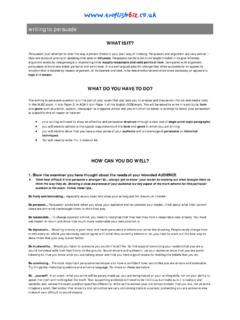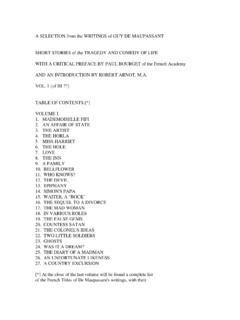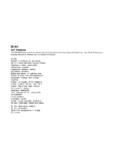Transcription of Analysing Moving Image Texts: ‘Film Language’
1 Analysing Moving Image Texts: Film Language Film language describes the way film speaks to its audiences and spectators. Directors, producers and editors work to create meaning from the Moving images of film, video and television. We decode these meanings in a not dissimilar way to interpreting spoken and written language. As with words, but more so, we don t merely read what we see we bring to our interpretation of Moving images a range of pre-existing expectations, knowledge and shared experiences that shape the meaning we take from what we see. An important aspect of film language is its compelling nature and its appearance of reality (what is called verisimilitude ); it is not only as if we are watching an authentic window on the world , it s a window we want to keep on watching like peaking nosily through the window at an argument in the street, enjoying guessing where it will lead!
2 Through these means, Moving images work to entertain, inform and educate but also persuade us to see the world in a particular way. SIGNS, CODES and CONVENTIONS Terms: denotation, denotes, denoting; connotation, connotes, connoting; iconic, iconicity; index, indexical, indexicality; symbol, symbolic, symbolically, Semiotics is a way of explaining how we make meaning. Semiotics recognises that all meaning is encoded in things that create meaning. When we see objects and images or hear / read words we cannot perceive more than an idea. This idea is what we call meaning . We have learned to decode this meaning as we grow up and are educated. The important realisation is that such meaning is not our own idea but someone else s.
3 For example, if you read the word coward you decode it by referring to values that our culture relates both to cowardice and its binary opposite term, heroism. In semiotics, a sign is the smallest single unit of meaning we can decode and which contributes to overall meaning, your clothes are a group of fashion signs and might have been encoded by you consciously or otherwise to create the meaning of coolness ; the FCUK on your T-shirt, for example, is a group of signs that create a code of, perhaps, youthful rebelliousness. Simplistically speaking, meaning exists at two levels : a sign always acts at a basic level called its denotation; this is a literal meaning; but, when it occurs in certain contexts, a group of signs a code can also suggest or connote extra meaning, a rose denotes a kind of flower; but when handed to a girl by a boy, it also acts to connote romance (and, importantly, in a media text, this would also act to reinforce ways of thinking about how romance should ideally be conducted one of our society s dominant ideologies).
4 In semiotics, a code is any group of signs that seem to fit together naturally to create an overall unit of meaning ( the rose is a sign which when added to the signs of a girl and a boy creates the romance cultural code ; of course, we could call the petals signs, too if they were wilting, the code would be read ). Film ic codes are a form of technical code because filmic equipment is needed to create them, cameras, microphones, lighting, etc. In semiotics there are three basic types of sign and code: Iconic signs and codes are created to appear exactly like the thing itself, an Image of a cowboy looks like signifies a cowboy. importantly, iconic codes always act to represent more than the thing itself, when we see an Image of a cowboy, our culture associates ideas of toughness and action with this particular iconic code (which also acts to reinforce what masculinity means in our culture an ideological meaning).
5 Indexical signs are different. They act by indirectly pointing or suggesting what they mean by acting as cues to existing knowledge, smoke signifies fire, sweating suggests hotness or exercise. These codes are a kind of media shorthand. They are very common and useful to media producers. Symbolic codes act as signifiers of meaning totally disconnected from what they denote, a red heart shape acts only to symbolise love; a white dove symbolises peace; red symbolises danger, power or sexuality, white symbolises innocence, etc. An important realisation is that the meaning a code communicates is always culturally determined, we learn the meaning as we grow up in a particular group, society or culture, the national flag means much more than its denotation of a piece of coloured cloth; it also acts to connote patriotism and pride.
6 An important filmic and media code is the enigma code which work by creating an intriguing question that the media text will go on to answer. Cinema trailers and posters use enigma codes to tempt the viewers. The term convention is important; it refers to an established way of doing something; we are so used to conventional ways that fail to account for their effect and often see them as somehow natural yet are anything but. So: women in Westerns are conventionally either very good (the Madonna ) or very bad (the whore ), and this seems entirely normal within this film genre; equally, the wheels of a car always screech; a guns always kills outright; a punch always knocks a person out cold.
7 Genre and narrative are important media conventions (see later), as are editing techniques and the use of certain shot types (such as an establishing shot sequence or montage see below). MISE-EN-SC NE ( all that the director puts into the scene and records on camera.) Cinema and TV codes are created within an area bounded by the edges of a screen. What is shown is entirely controlled by the producer or director and by controlling what is in the frame controls the audience or spectators understanding. Asking who, what and where of the characters and objects and their relative positions, expressions, appearance, costume, make-up, scenery, props, lighting, sounds, etc. in the mise-en-scene will help you analyse and understand it.
8 What effects are created in a particular mise-en-scene, what meaning do they have (both denotation and connotation), how they have been created and why created that particular way (which is director s purpose perhaps to develop a character, a mood, the storyline or plot and always to contribute to the exploration a deeper meaning or idea, a theme). EDITING Editing is a way of compressing time and space or creating the effect of a dream sequence or flashback; it usually is seamless and natural-seeming such that we tend not to even notice it. Editing is the cutting and joining of lengths of film to place separate shots together yet still manage to suggest a sense of a continuing, connected and realistic flow of events and narrative (see below).
9 A montage is an edited series of shots that works as an individual unit of meaning greater than the individual mise-en-scenes from which it is created. Continuity editing refers to editing techniques that keep the sense of narrative flow such as matched or eye-line cuts. A jump-cut is a dramatic edit that breaks time / space continuity yet still appears continuous and natural ; an MTV edit is a rapid sequence of fast jump cuts that creates a conscious effect such as in music videos; a cross-cut follows action in two separate scenes; a follow-cut follow action to its consequence, a character looking out cuts to what they look at. Fades (sometimes to black) and dissolves create the sense of scenes Moving forward.
10 A sound-bridge carries sound across shots. Parallel action allows two scenes to be viewed yet still retain the continuity and realism and uses cross cuts. A sequence is a series of shots ( a montage) that leads up to a climax as in a story sequence. SHOT TYPES A shot is a single take. An establishing shot is usually a long shot that helps to set the scene; it helps the spectator locate him or herself within the narrative (see below) of the film. It is often followed by a mid-shot Steve Campsall - 27/06/2002 (Rev. 17/12/2005; 14:18:24) Media - GCSE Film Analysis Guide (3) - SJC 2 (MS) then a close-up (CU). A subjective point-of-view shot (POV) is an eye-line shot that allows the spectator to feel as if he or she is a part of the scene.










![arXiv:1705.03394v1 [physics.pop-ph] 27 Apr 2017](/cache/preview/3/d/a/4/1/f/b/6/thumb-3da41fb6ae0183fa54b7178af1964a9e.jpg)



